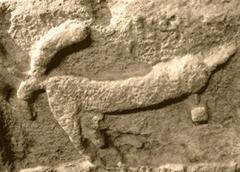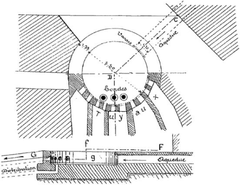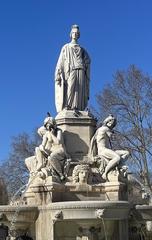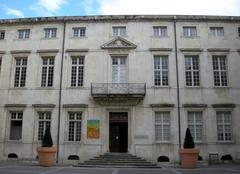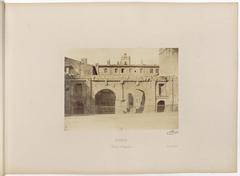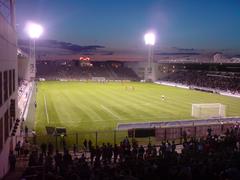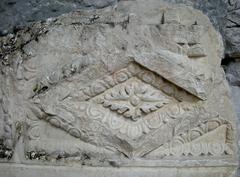
Sanctuaire De La Fontaine: Visiting Hours, Tickets, and Your Complete Guide to Nîmes’ Historic Sanctuary
Date: 04/07/2025
Introduction
The Sanctuaire De La Fontaine in Nîmes, France, is a multifaceted historical and cultural landmark that bridges millennia of sacred tradition, Roman innovation, and French landscape artistry. Originating around a revered spring venerated by the earliest settlers, the sanctuary evolved into a monumental Roman complex and, later, into the heart of one of Europe’s first formal public gardens. Whether you are a history enthusiast, a lover of classical architecture, or seeking tranquil green spaces, this guide provides essential information on the sanctuary’s history, architectural highlights, visiting hours, tickets, accessibility, and tips for making the most of your time in Nîmes.
Table of Contents
- Ancient Origins and Sacred Significance
- Roman Transformation and Architectural Flourishing
- Medieval Decline and 18th-Century Revival
- The Jardins de la Fontaine: Design and Features
- Visiting Information: Hours, Tickets, and Accessibility
- Must-See Highlights
- Practical Tips for Visitors
- Nearby Attractions
- Frequently Asked Questions (FAQ)
- Conclusion
- References and Further Reading
Ancient Origins and Sacred Significance
The story of the Sanctuaire De La Fontaine begins long before Roman conquest, with a perennial spring at Mont Cavalier’s base serving as both a practical resource and a focal point for religious rites. Archaeological finds, including Gallo-Greek inscriptions and ritual objects, confirm that the local god Nemausus was worshipped here, reflecting a widespread Mediterranean tradition of sacred water cults (Persee). The spring’s sanctity shaped the nascent city’s location and early identity, with the first settlements dating back to the end of the 6th century BCE.
Roman Transformation and Architectural Flourishing
With the Roman colonization of the region in the late 1st century BCE, the sanctuary underwent a monumental transformation. The indigenous place of worship was reimagined as an Augusteum—a sanctuary dedicated to the imperial cult—around 25 BCE (Musée de la Romanité). This complex blended sacred, civic, and leisure functions, featuring:
- Grand stairways and terraces
- Porticoes and colonnades
- Monumental water features integrated with advanced hydraulic systems
The site was strategically positioned near the city’s northern edge, with the forum 500 meters to the southeast, emphasizing the dual prominence of civic and religious life (Musée de la Romanité).
The Temple of Diana, the sanctuary’s best-preserved monument, is a striking example of Roman engineering and architectural sophistication. Despite the name, there is no direct evidence that it was dedicated to Diana; it may have served as a library or assembly hall, as suggested by its decorative niches and vaulted design.
Roman water management was another highlight, with the sanctuary’s nymphaeum (fountain house) and related structures showcasing advanced engineering. The nearby Pont du Gard aqueduct, while not on-site, is part of the same Roman water network that supplied Nîmes (Musée de la Romanité).
Medieval Decline and 18th-Century Revival
The sanctuary experienced centuries of neglect following the fall of the Roman Empire. The Temple of Diana was used as a church and later suffered damage during the Wars of Religion. The site remained largely dormant until the 18th century, when droughts and a renewed interest in antiquity sparked its restoration (Archives Gard).
In the 1740s, royal engineer Jacques-Philippe Mareschal and local architect Pierre Dardailhon undertook an ambitious project to create the Jardins de la Fontaine—one of Europe’s earliest public gardens—integrating the Roman ruins within a masterpiece of French landscape design (Slow Travel UK). The lower garden’s terraces, balustrades, and ornamental fountains reflect classical French style, while higher paths and botanical sections evoke a more naturalistic aesthetic.
The Jardins de la Fontaine: Design and Features
Overview
Today, the Jardins de la Fontaine cover 15 hectares, offering a harmonious blend of Roman archaeology and Enlightenment-era landscaping (France This Way). Key features include:
- A monumental central basin fed by the ancient spring
- Ornamental fountains and classical statues
- Tree-lined avenues and Mediterranean flora
- The atmospheric Temple of Diana
- The imposing Tour Magne atop Mont Cavalier, offering panoramic city views
The Temple of Diana
Dating from the 1st century CE, the Temple of Diana’s vaulted ceilings and decorative niches evoke the grandeur of Roman sacred spaces (France Travel Planner). The building’s true function remains debated, but its preservation makes it a centerpiece of the gardens.
The Tour Magne
This 30-meter Roman tower was once part of Nîmes’ city walls. Today, visitors can climb to the top for sweeping views—a reward for those able to manage the steep ascent (France Travel Planner).
Botanical and Stone Gardens
Upper sections feature Mediterranean and exotic plants, cypress and olive groves, and a tranquil pond at the Bassin Montgolfier (The South of France).
Artistic Details
Grand staircases, ornate vases, wrought-iron gates by Leclair, and classical sculptures lend the gardens a sense of elegance and historical depth (France This Way).
Visiting Information: Hours, Tickets, and Accessibility
Opening Hours
- Winter (16 September – 31 March): 7:30 am – 6:30 pm
- Summer (1 April – 15 September): 7:30 am – 10:00 pm
(Ville de Nîmes)
Admission and Tickets
- Gardens and Sanctuary: Free entry
- Tour Magne: ~€5 for adults (discounts for children/seniors), tickets available on-site or online
- Guided Tours and Events: Some require tickets or reservations
Accessibility
- Southern gardens: Wheelchair accessible
- Northern and upper areas (including Tour Magne): Steep and less accessible
- Restrooms and seating are available; assistance can be requested for visitors with limited mobility
Must-See Highlights
- Nymphaeum: Roman fountain house and the sanctuary’s focal point (Navaway)
- Temple of Diana: Atmospheric Roman ruins with vaulted halls
- Tour Magne: Panoramic city views after a rewarding climb
- Central Basin and Fountains: Picturesque spot for relaxation and photography
- Botanical Areas: Mediterranean and exotic plantings on Mont Cavalier
- Artistic Features: Classical statues, stairways, and ornamental vases
Practical Tips for Visitors
- Arrive Early or Late: To avoid crowds and heat, visit early morning or late afternoon, especially in summer (Brainy Backpackers)
- Wear Comfortable Shoes: Expect uneven paths and stairs
- Bring Water and Sun Protection: Summer temperatures can be high
- Picnic Allowed: Designated areas available
- Photography: Early morning and evening offer the best light
- Check for Events: Concerts and festivals may affect access (Ville de Nîmes)
Nearby Attractions
Extend your visit by exploring other top sights within walking distance:
- Maison Carrée: One of the world’s best-preserved Roman temples
- Les Arènes (Nîmes Arena): A grand Roman amphitheater
- Musée de la Romanité: Modern museum celebrating Nîmes’ Roman past
- Pont du Gard: Spectacular Roman aqueduct a short drive away
Frequently Asked Questions (FAQ)
Q: What are the opening hours?
A: The Jardins de la Fontaine are open daily, from 7:30 am to dusk (seasonal variations apply).
Q: Is entry free?
A: Yes, the gardens and sanctuary are free. The Tour Magne and certain tours/events require tickets.
Q: Are guided tours available?
A: Yes, through the Nîmes tourism office and local providers.
Q: Is the site accessible for wheelchairs?
A: Most main paths and southern gardens are accessible; upper sections and some ruins are not.
Q: Are dogs allowed?
A: Yes, on a leash.
Q: Can I picnic in the gardens?
A: Yes, in designated areas.
Conclusion
The Sanctuaire De La Fontaine stands as a testament to Nîmes’ layered history, from its sacred spring and Roman grandeur to Enlightenment-era gardens. Free and open to all, the sanctuary invites exploration, reflection, and discovery. With its unique combination of historical depth, architectural splendor, and natural beauty, it is an essential destination for anyone visiting southern France.
Plan your visit today: Check Nîmes Tourism for up-to-date information, and consider the Audiala app for guided audio tours and interactive maps. Stay tuned for local events, and don’t forget to explore nearby Roman monuments to complete your journey through Nîmes’ remarkable past.
References and Further Reading
- Persee
- Musée de la Romanité
- Slow Travel UK
- France.fr
- Archives Gard
- France This Way
- France Travel Planner
- The South of France
- Ville de Nîmes
- Lonely Planet
- Brainy Backpackers
- GPS My City Tour
- Navaway
Images:
- Nymphaeum at Sanctuaire De La Fontaine, Nîmes
- Temple of Diana, ancient library in Nîmes
- Terraces and gardens at Jardins de la Fontaine, Nîmes




